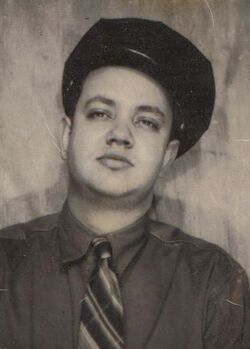
| Version | Summary | Created by | Modification | Content Size | Created at | Operation |
|---|---|---|---|---|---|---|
| 1 | Catherine Yang | -- | 726 | 2022-12-02 01:52:24 |
Video Upload Options
1. Introduction
Joseph Raymond "Ray" Butts (September 22, 1919 – April 20, 2003) was an American inventor and engineer best known for designing several devices that influenced the evolution of electrified music, in particular those used with the electric guitar. Most notably, Butts is the inventor of the EchoSonic, a guitar amplifier with a built-in tape echo, and the FilterTron, the first humbucker guitar pickup (used extensively on Gretsch guitars). He was active in other fields from studio equipment maintenance to sound engineering, and had intimate working relationships with people such as Sam Phillips at Sun Studios and Chet Atkins.[1]
2. Biography
As a toddler, Butts moved with his father to Cairo, Illinois, where he developed an interest in electronics, building his first crystal radio in 1928 when he was just eight years old.
2.1. Musical Career
Butts was an accordion player. In the early 1940s, he moved to Calumet City, Illinois, where he played at several clubs. His band leader had a chance to join with a traveling tent show billed as a "Hillbilly Jamboree featuring the Colorado Cowhands". They played the southern coastal states before ending up in Nashville, Tennessee, where they played alternating days on the WSM's Morning Show. He returned to Calumet City, playing nights from 8:00pm to 5:00am, but his career as a musician ended abruptly when his father had a heart attack, and he moved back to Cairo.[1]
2.2. "Ray Butts' Music" Store (194?–1962)
Back in Cairo, Butts worked for an appliance store as a warranty repairman,[1] servicing GE products ranging from washing machines to radios. Soon he started his own business, focusing on musical instruments and amplification, "Ray Butts' Music". It was a small music store; Butts' wife Ann ran the store out front and kept the books, while he tinkered in the back. This tinkering, and his connections with local musicians, led to the development of the EchoSonic.
2.3. EchoSonic
In 1952, a local guitar player named Bill Gwaltney (an admirer of Les Paul, who was known for his tape experiments) sparked Butts' interest in creating the "sound-on-sound" effect with live guitar. An early amplifier which Butts built for him used a 15-watt Gibson amplifier and a wire recorder, with disappointing results,[1][2] and after some more experimentation Butts settled on the new plastic tape made by 3M, and soon created the Echosonic: Bill Gwaltney bought the first one.[1]
In 1954 Butts went to Nashville where he looked up Chet Atkins in the phone book. After making contact and meeting, Atkins sold a brand new Fender Twin amplifier to buy the second Echosonic amp, which he went on to use in many famous recordings, including his rendition of "Mister Sandman".[2] The next year, Elvis Presley's guitarist Scotty Moore was the next big name to start using the EchoSonic,[3] which he did on most of Elvis' late Sun and early RCA singles, in addition to the 1968 comeback special. Butts's tape-loop technology was the basis for the later Echoplex, for which he received a "nominal sum" from the manufacturers.[4] Though it has been represented in error by some authors in later years, Butts had received a U.S. patent for his tape echo technology in 1957.[5]
2.4. Gretsch Filter'Tron Pickup
In 1954 Gretsch began plans to produce the first Chet Atkins-endorsed guitar model, the Gretsch 6120. Atkins recorded much of his music of the 1950s with the Echosonic,[4] and had serious hum problems caused by the single-coil pickups and an unshielded transformer in the amplifier. Butts finally connected two single-coil pickups serially and out of phase, creating the first humbucker. Butts did not receive a patent until later, when it became the Gretsch Filter'Tron, and Gibson is often credited with developing the first humbucker.[6] Throughout the early years of production, Butts insisted on making all the Filter'Tron pickups by hand. Mass production of the Gretsch Filter'Tron (or simply Filtertron) pickup began in 1957.
References
- Dave Kyle, "An Interview with Ray Butts", Vintage Guitar, November 1994 http://scottymoore.net/Ray_Butts_interview.html
- Rich Kienzie, "Riffs, Amps, and Butts", Guitar Player, March 1990, p.14
- Blackett, Matt. "101 Greatest Moments in Guitar History, 1954–1957". Guitar Player. http://www.guitarplayer.com/article/101-greatest-moments-in-guitar-history-1954---1957/8755. Retrieved 4 December 2012.
- Hunter, Dave (2005). Guitar Rigs: Classic Guitar & Amp Combinations. Hal Leonard. pp. 50–54. ISBN 9780879308513. https://books.google.com/books?id=p1-kULtG9tgC&pg=PA54. Retrieved 4 December 2012.
- "U.S. Patent 2,804,499". United States Patent and Trademark Office. 27 August 1957. http://pdfpiw.uspto.gov/.piw?PageNum=0&docid=02804499&IDKey=30DCA4F21423%0D%0A&HomeUrl=http%3A%2F%2Fpatft.uspto.gov%2Fnetacgi%2Fnph-Parser%3FSect1%3DPTO1%2526Sect2%3DHITOFF%2526d%3DPALL%2526p%3D1%2526u%3D%25252Fnetahtml%25252FPTO%25252Fsrchnum.htm%2526r%3D1%2526f%3DG%2526l%3D50%2526s1%3D2804499.PN.%2526OS%3DPN%2F2804499%2526RS%3DPN%2F2804499.
- Atkins, Chet; Cochran, Russ (2003). Chet Atkins: Me and My Guitars. Hal Leonard. pp. 77–80. ISBN 9780634055652. https://books.google.com/books?id=UjIj7tCvbtwC&pg=PA77. Retrieved 4 December 2012.

Location: Ethel, Mississippi, U.S.




